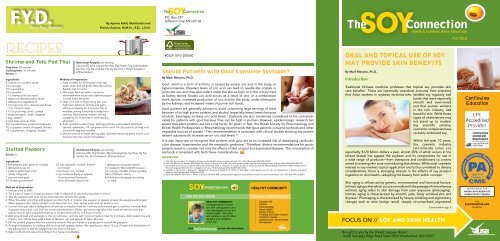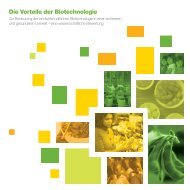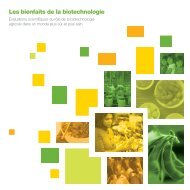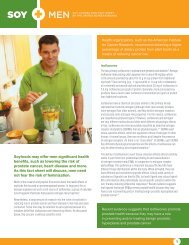Create successful ePaper yourself
Turn your PDF publications into a flip-book with our unique Google optimized e-Paper software.
F.Y.D.From Your DietitianBy Aparna Kohli, Nutritionist andPatricia Samour, M.M.Sc., R.D., L.D.N.The<strong>SoyConnection</strong>p.o. Box 237Jefferson City, MO 65102TheSoy Health & Nutrition News About <strong>SoyConnection</strong>RecipesShrimp and Tofu Pad ThaiPrep time: 30 minutesCooking time: 10 minutesServes: 6Ingredients8 ounces rice noodles, dried1/2 cup sugar1/4 cup ketchup1/4 cup water1 1/2 tablespoons soy sauce2 teaspoons Worcestershire sauce2 tablespoons vegetable oil1 1/2 cups tofu, firm, drained and dicedinto 1/2 inch cubes1 1/2 cups shrimp, small, cooked2 teaspoons garlic, fresh, chopped1 egg, beaten3 cups bean sprouts, fresh1/2 cup edamame, cooked and drained1/2 cup green onions, chopped, divided1/2 cup peanuts, chopped, dividedStuffed PeppersServes: 4Ingredients4 bell peppers (red, green or orange)3 tablespoons soy oil1 medium yellow/red onion(finely chopped)1 clove minced garlic1/2 lb lean ground beefMethod of Preparation:1. Soak noodles for 30 minutes in hot tapwater; drain and set aside. (Noodles will beflexible, but not soft.)2. Mix sugar, ketchup, water, soy sauce,worchestershire sauce and cayenne pepperin small bowl; set aside.3. Heat oil in wok or large frying pan overhigh heat. Add tofu, shrimp and garlic,stirring constantly, for 3 minutes. Stir innoodles, stirring constantly to keep fromsticking. Add ketchup mixture, stirringconstantly, for 2 minutes or until sauce isabsorbed.4. Push noodles to side of pan. Add egg and stir until cooked. Add beansprouts, edamame, 1/4 cup green onions and 1/4 cup peanuts, stirring untilmixed with egg and noodles.5. Mound mixture on large serving plate. Sprinkle remaining green onions andpeanuts over top. Serve immediately.1/2 cup soybeans, cooked, drainedand rinsed1 cup brown rice, cooked1 cup tomatoes (finely chopped);If using canned tomatoes,drain off excess liquid first)Nutritional Analysis: per servingCalories 430 (31% calories from fat), 20g Protein, 57g Carbohydrate,4g Fiber, 15g Fat, 2.5g Sat. Fat, 0g Trans Fat, 110mg Cholesterol,670mg SodiumNutritional Analysis: per servingCalories 248, 20g Protein, 25g Carbohydrate, 5g Fiber, 9g Fat,2g Sat. Fat, 35 Cholesterol, 262mg Sodium51 tablespoon chopped cilantro1/2 teaspoon Worcestershire sauce1/2 cup soy cheddar cheese (grated)Dash of Tabasco sauceSalt and ground pepper accordingto taste.Method of Preparation:1. Preheat oven to 340F.2. Put 5 cups of water in a large saucepan. Add ½ teaspoon of salt and bring water to a boil.3. Take the peppers and chop off the stem tops and remove the seeds.4. When the water is boiling, add peppers and boil for 3–4 minutes. Use a spoon or spatula to keep the peppers submerged.When peppers start taking a bright color, take them out, drain excess water and set aside to cool.5. In a non-stick pan add 3 tablespoons oil and set on medium heat for 1 minute. Add minced garlic, cook for 1 minute. Addchopped onions and cook until the onions are translucent. (Note: red onions may take a few more minutes to cook thanyellow onions). Add chopped tomatoes to mixture and cook for 2–3 more minutes.6. Add ground beef and soybeans to the non-stick pan, and mix well. Cook at medium heat for 2 minutes. Add cooked rice andcilantro. Turn off the heat. Add a dash of Tabasco, salt and pepper to taste. Mix well.7. Fill the cooked peppers with the meat/soy mixture. Use your hands or a large spoon to stuff the peppers.8. Arrange the peppers in a baking dish and top with grated cheese, then gently pour about ¼ cup of water into the bottom ofthe baking dish so that the peppers do not stick to the pan.9. Bake for 25–30 minutes until stuffing is hot. Serve immediately.#0327-1010-250000Should Patients with Gout Consume Soyfoods?By Mark Messina, Ph.D.Gout, which is a form of arthritis, is caused by excess uric acid in the body, orhyperuricaemia. Elevated levels of uric acid can lead to needle-like crystals injoints but uric acid may also collect under the skin as lophi or in the urinary tractas kidney stones. Excess uric acid occurs as a result of one, or a <strong>com</strong>binationthree factors: increased production of uric acid by the body; under-eliminationby the kidneys; and increased intake of purine-rich foods.Gout patients are generally advised to avoid consuming large servings of meatbecause of its high purine content, and alcohol (especially heavy beers) becausealcoholic beverages increase uric acid levels. 1 Soyfoods are also sometimes considered to be contraindicatedfor patients with gout because they can be high in purines. However, epidemiologic research hasshown that plant proteins are not a risk factor for gout. 2 In fact, the British Society for Rheumatology andBritish Health Professionals in Rheumatology re<strong>com</strong>mends that gout patients consume soyfoods and othervegetable sources of protein. 3 This re<strong>com</strong>mendation is consistent with clinical studies showing soy proteindoesn’t substantially increase serum uric acid levels. 4,5It is also important to recognize that patients with gout are at an increased risk of developing cardiovasculardisease, hypertension and the metabolic syndrome. 1 Therefore, dietary re<strong>com</strong>mendations for goutypatients need to consider not only the effects of diet on gout but associated diseases. The consumption ofsoyfoods is consistent with both these considerations.References1. Choi HK. A prescription for lifestyle change in patients with hyperuricemia and gout. Curr Opin Rheumatol 2010;22:165-72.2. Choi HK, Atkinson K, Karlson EW, Willett W, Curhan G. Purine-rich foods, dairy and protein intake, and the risk of gout in men. N Engl J Med 2004;350:1093-103.3. Jordan KM, Cameron JS, Snaith M, Zhang W, Doherty M, Seckl J, Hingorani A, Jaques R, Nuki G. British Society for Rheumatology and British Health Professionals inRheumatology guideline for the management of gout. Rheumatology (Oxford) 2007;46:1372-4.4. Yamakita J, Yamamoto T, Moriwaki Y, Takahashi S, Tsutsumi Z, Higashino K. Effect of Tofu (bean curd) ingestion and on uric acid metabolism in healthy and goutysubjects. Adv Exp Med Biol 1998;431:839-42.5. Garrel DR, Verdy M, PetitClerc C, Martin C, Brule D, Hamet P. Milk- and soy-protein ingestion: acute effect on serum uric acid concentration. Am J Clin Nutr 1991;53:665-9.JOIN THE DISCUSSION.<strong>com</strong>HEALTHY COMMUNITYmessage boards connectyou with colleagues for yourown discussions on soy andhuman health. Get newsand updates or ask Dr. MarkMessina your questionsabout soy.Visit <strong>SoyConnection</strong>.<strong>com</strong> and join the discussion.HEALTHY COMMUNITYDISCUSSION CATEGORIES INCLUDE:• Soybean Oil• Protein• Biotechnology• Heart Health• Breast Cancer• Prostate and Colon Cancer• Children's Health• Osteoporosis / Bone Health• MenopauseOral and Topical Use of SoyMay Provide Skin BenefitsBy Mark Messina, Ph.D.IntroductionTraditional Chinese medicine professes that topical soy provides skincare benefits. 1 There are reportedly anecdotal accounts from scientiststhat Asian workers in soybean factories who handled soy regularly hadhands that were especiallysmooth and even-tonedand that women workersin the tofu industry hadbeautiful skin. While thesetypes of observations maynot stand up to modernday scientific scrutiny,cosmetics <strong>com</strong>panies havecertainly embraced soy.Within the past 10 years,the cosmetic industry( wo r l d w i d e s a l e s a rereportedly $170 billion dollars a year, almost 25% of which occurs in theUnited States) has tapped the soybean and its <strong>com</strong>ponents for use ina wide range of products—from shampoos and conditioners to creamsaimed at evening skin tone and reducing blotchiness. While most cosmeticinterest in soy involves topical application and is thus unrelated to dietaryconsiderations, there is emerging interest in the effects of soy productingestion on skin health—adopting the beauty from within concept.Skin aging is influenced by genetic, environmental and hormonal factors.Intrinsic aging is that which occurs normally with the passage of time whereasextrinsic aging refers to skin damage from solar exposure (photoaging).Intrinsic aging is characterized by smooth, pale, finely wrinkled skin anddryness. 2 Photoaging is characterized by severe wrinkling and pigmentarychanges such as solar lentigo (small, sharply circumscribed, pigmentedFOCUS ON // Soy and Skin HealthBrought to you by the United Soybean Board16305 Swingley Ridge Road Suite 150 • Chesterfield, MO 63017Continued on pg. 2Fall 2010ContinuingEducationApproved by theAmerican Academy ofNurse PractitionersVisit<strong>SoyConnection</strong>.<strong>com</strong>for details.
Oral and Topical Use of Soy May Benefit Skin Continued from pg. 1flat, distinct, colored areas of the skin surrounded bynormal-appearing skin) and mottled pigmentation. 3With respect to the soy-cosmetic connection,it is especially intriguing that there are multiple<strong>com</strong>ponents in the soybean that appear tobeneficially affect various aspects of skin health asdiscussed below.Topical ApplicationIn 2001, Paine et al. 4 showed in vitro that soybeanprotease inhibitors and soymilk when addedto keratinocytes (the predominant cell type inthe epidermis) in culture and, in vivo, when appliedtopically to microswine resulted in depigmentationand prevented ultraviolet (UV)-induced pigmentation.These results concur with the findings of a clinicalstudy in which significant skin lightening wasfound in patients with hypermelanosis (excessivepigmentation of the skin)after a 3 wk treatment witha soybean extract containingsoybean trypsin inhibitor(STI). 5 A second study by thisresearch group also founda beneficial effect of a soyextract when topically appliedto Asian women with solarlentigines. 6 The two mainsoybean protease inhibitors,the Kunitz inhibitor (soybeantrypsin inhibitor) and theBowman Birk chymotrypsinand trypsin inhibitor (BBI) <strong>com</strong>prise as much as 6%of the total soybean protein. 7Recently, a placebo-controlled trial that included65 women with moderate facial photodamageevaluated the effects of a soy moisturizer containingnondenaturated STI and BBI. 8 At the end of the12-week study period, resultsshowed the soy moisturizer hadsignificantly improved mottledp i g m e n t a t i o n , bl o t c h i n e s s,dullness, fine lines, overall texture,overall skin tone, and overallappearance. Furthermore, a test of<strong>com</strong>mercial anti-wrinkle productsshowed that topical applicationof a soy lotion was found tobeneficially affect the epidermisof hairless mice. 9 However, thechemical <strong>com</strong>position of the lotionThe Soy Connection, funded by farmer checkoff dollars, is produced bythe United Soybean Board. An electronic version of this newsletter, with<strong>com</strong>plete references, can be found at www.soyconnection.<strong>com</strong>.Editorial Advisory BoardMark Messina, Ph.D., ChairmanPatricia Samour, M.M. Sc., R.D., L.D.N.Guy Johnson, Ph.D.Suzanne Vieira, M.S., R.D., L.D.N.Elaine Doyle, F.N.P./G.N.P.– B.C.Editorial StaffSteve Veile, Managing Editorwas not described. The <strong>com</strong>bination of soy (nodescription provided) and jasmine was also shown toproduce improvements in skin health when appliedfor three months to women aged 45 to 65. 10 Thisstudy is noteworthy because it was the first to usemultiphotonic tomography to evaluate in vivo theeffects of cosmetics on skin structures.Research suggests a <strong>com</strong>bination of soy moleculesis likely to be more efficacious than any individualone. 11 In addition to the protease inhibitors, bothsoybean phytosterols and isoflavones are beinginvestigated for cosmetic applications. For example,when soybean phytosterols were applied to theskin of volunteers and methyl nicotinate-inducederythema (redness of the skin caused by hyperemiaof the capillaries) was monitored using reflectancespectrophotometry, three days after tape stripping,the sites treated with the formulation containingphytosterols showed an appreciable recovery ofbarrier function <strong>com</strong>paredto those treated with avehicle control without soyphytosterols. 12Interest in isoflavones is notsurprising given that theybind to estrogen receptors– which are present in theskin 13,14 – and that estrogent h e r a p y i s t h o u g h t t oimprove a number of skinparameters 15-18 including skinelasticity, 19 water-holdingcapacity, 20 pigmentation 21 and vascularity. 22 Skinappendages, such as hair follicles, are also influencedby estrogens. 23 Importantly, isoflavonespreferentially bind to 24 and transactivate 25 estrogenreceptor-β in <strong>com</strong>parison to estrogen receptor-a, andit is the former that is the predominant receptor inthe skin. 13,14 However, isoflavones may also affect skinSend <strong>com</strong>ments or questions to:The Soy ConnectionP.O. Box 237Jefferson City, MO 65102Email: kyelr@<strong>com</strong>muniqueinc.<strong>com</strong>independent of estrogen receptorbinding. To this point, pretreatmentof human skin with the soybeanisof lavone genistein inhibitedUV-induced epidermal growth factorreceptor tyrosine kinase activity andfavorably affected several othersignal transduction pathways in amanner suggesting this isoflavonemay prevent photoaging. 26 Further,in a placebo-controlled in vivostudy, topical application of a soyisoflavone emulsion significantlyenhanced the number of dermalpapillae after two weeks, which isimportant considering that flatteningof the dermal-epidermal junction isthe most important reproduciblechange in aging skin, indicating that topical soy can“rejuvante the structure of mature skin.” 11Genistein also prevents UV light-induced oxidativeDNA damage in vitro and when applied to rodents,which suggests it could have a role in preventingphotocarcinogenesis. 27-29 This isoflavone alsoprotects against damage caused by UV-B irradiationwhen applied to human reconstituted skin. 30 Equol,the bacterially-derived metabolite of daidzein whichis receiving considerable attention for its potentialhealth properties, 31 also protects against UV inducedskin damage. 32 Interestingly, the chemopreventiveeffects of soy are not limited to isoflavones astopical application of nondenatured (but notheat-denatured) soymilk once a day, 5 days a week,inhibited UV-B light induced skin tumors in hairlessmice. 33 Topical applications of STI and the BBI alsoinhibited the tumor formation, but not as effectivelyas nondenatured soymilk.These findings in animals concur with those of aBrazilian study, in which 35 postmenopausal womenwere treated topically with either estradiol orisoflavones for 24 weeks. Facial skin biopsies wereperformed on each patient before and after thetreatment. Both treatments resulted in improvementsin histomorphometrical parameters; althoughthe effect of estrogen was greater than that ofisoflavones. 34 Research has shown that isoflavonesare absorbed from the skin and Huang et al. 35proposed that topical delivery may serve as a potentroute for soy isoflavones against photoaging andphotodamage. In fact, Minghetti et al. 36 suggested thattopical administration could lead to lead to circulatingisoflavone levels sufficient to have systemic effects.B e n ef i t s o f i s o f l avo n e s we realso noted in a study in whichBifidobacterium-fermented soymilk(BE) extract containing genisteinand daidzein topically applied to theskin of hairless mice for six weekssignificantly restored changes inthe elasticity and viscoelasticity ofthe skin, increased hyaluronic acidcontent, and increased hydrationand thickening of the skin. Hyaluronicacid is a major <strong>com</strong>ponent of skinwhere it is involved in tissue repair.Topical application of a gel formulacontaining 10% BE to the humanforearm for three months alsoimproved skin elasticity. 37Finally, soybean protease inhibitors and soymilk havebeen shown to slow the growth rate of hair in miceand in men when topically applied to the face andto the legs. 38 And genistein was shown to decreasehair growth by 60 to 80% when hair follicles isolatedfrom scalp biopsies were treated in culture. 39 Topicaltreatments with 17-β-estradiol have also been shownto inhibit hair growth in mice, while an estrogenreceptor antagonist initiated hair growth in thissystem. 40,41 Since protease inhibitors don’t interactwith estrogen receptors, soymilk appears to containat least two different molecules working throughdifferent mechanisms to inhibit hair growth.Oral AdministrationIt has been reported that wrinkling in Asians is notnoticeable until the age of 50 and that even thenits degree is not as marked as in the Caucasianpopulation. 42 Although many fac tors such aspigmentation and lifestyle certainly play a role inphotoaging, it is conceivable that nutrition has amajor effect as well.One of the first studies to evaluate the effects of oralingestion of a soy product on skin health involved 80postmenopausal women who were given a placeboor two tablets containing soy extract, fish proteinpolysaccharides, extracts from white tea, grape seedand tomato, vitamins C and E as well as zinc andchamomile extract for six months. 43 Compared to theplacebo, clinical grading showed that the active grouphad improved significantly in several parametersincluding reduced periocular and perioral wrinkles,mottled pigmentation, laxity and sagging and undereye dark circles. Photo evaluation also showed thatthe active group had significantly greater overallfacial improvements after three and six monthsof treatment. The obvious limitation to this studydesign is that it prohibits drawing conclusionsabout the specific contribution of any individual<strong>com</strong>ponent of the active treatment.In a second (pilot) study, two groups of 20 healthypostmenopausal women were each instructed toconsume their usual diet with or without 20 g/dof an isoflavone-rich soy protein. 44 There werestatistically significant improvements in facial-skinwrinkling, discoloration and overall appearancein the supplement group. The results, whileintriguing, should be considered preliminarybecause although there was a control group, thebenefits seen in the soy group could have simplyresulted from a general improvement in nutrition,possibly because of a higher protein intake in theactive group.In a third study, a skin punch was performed inthe gluteal region of 30 postmenopausal womenbefore and immediately after the end of treatmentwith 100 mg/d of an isoflavones-rich, concentratedsoy extract for six months. 45 Treatment resulted ina 9.5% increase in the thickness of the epidermisin 23 patients. In addition, the papillary indexwas reduced in 21 (70%) women. The amount ofcollagen in the dermis was increased in 25 women(86.2%); in 22 (75.8%) and 21 (70%) women theAbout the Authornumber of elastic fibers and dermal bloodvessels significantly increased, respectively.Although the results are encouraging, as in theprevious study, the lack of a true control grouplimits the implications of the findings.Finally, in mature, ovariectomized rats, genisteinin aglycone form (without a sugar attached tothe isoflavone) was recently shown to improveskin (wound) healing and tensile strength. 46In this study, genistein was subcutaneouslyinjected; however, it is noteworthy becausealthough both raloxifene and estradiol were alsoefficacious, genistein exerted a greater effectthan both of these treatments. Selective estrogenreceptor modulators (mixed estrogen agonists/antagonists) such as raloxifene and isoflavonesare receiving attention for their potential role inskin health. 47Summary and ConclusionsCosmetic industry use of soy and soy extractsin topically applied products appears to havescientific support. The impact of dietary soy onskin health in humans has been investigated toa very limited extent but the preliminary resultsprovide justification for continued researchin this area. Molecules found in relativelyhigh concentrations in the soybean are underinvestigation for their cosmetic applications evenbeyond those discussed in this article (isoflavones,phytosterols and protease inhibitors) such assaponins, 48 omega-6 and omega-3 fatty acids 49and vitamin E. 50 Isoflavone 51,52 and phytosterol 53absorption from oral ingestion readily occursalthough skin concentration data for these<strong>com</strong>pounds is lacking. Research also indicatesthat even large proteins, 54 such as the BBI, 55 canbe absorbed relatively intact in sufficient amountsto potentially exert physiological effects. Thus,there is certainly the potential for the dietary useof soy products to improve skin health. Whetherthat potential is realized will be determined byfuture research.Mark Messina, Ph.D. is the co-owner of Nutrition Matters, Inc., a nutrition consulting <strong>com</strong>pany, and is anadjunct professor at Loma Linda University. His research focuses on the health effects of soyfoods and soybean<strong>com</strong>ponents. He is chairperson of The Soy Connection Editorial Board.Complete references can be found at www.soyconnection.<strong>com</strong>2 3 4







